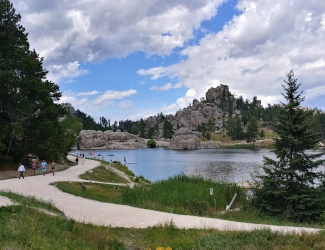
Image above: Sylvan Lake at Custer State Park, 2024. Courtesy America's Best History.
Spotlight on Lesser Known History
Custer State Park, South Dakota
America's Best History Spotlight
On this page we're going to Spotlight the lesser known historic sites and attractions that dot the history landscape across the USA and are worth a visit if you're in their area. And while they may be lesser known, some are very unique, and will be that rare find. You'll be, at times, on the ground floor, or maybe even know something others don't. It'll be fun. Visit them.

Custer State Park, South Dakota
Custer State Park is one of the largest state parks in the nation, located on the southern end of the Black Hills of South Dakota. With tons of wildlife roaming free, including a bit more than one thousand bison, big horn sheep, prong horn antelope, and more, Custer State Park is a magnificent natural park with plenty of campgrounds, Visitor Centers, and lodges to stay at or visit. A must see if you're heading to Mount Rushmore, the Badlands, or any western South Dakota site. The whole area will make you feel like you've stepped back in time, but with modern amenities.
There's a yearly roundup in September of the herd of bison that has become a favorite attraction. The herd grows to over one thousand five hundred after the new births each year, but the park can only hold from one thousand to one thousand forteen hundred with enough food and space, so five hundred or so must be culled and sold. Kinda sad, but a necessary part of park management. We haven't heard of any roundup of the antelope or sheep.
Photo above: Bison on the Prairie, 2024. Courtesy America's Best History.
Sponsor this page. Your banner or text ad can fill the space above.
Click here to Sponsor the page and how to reserve your ad.
Info, What's There Now, History Nearby
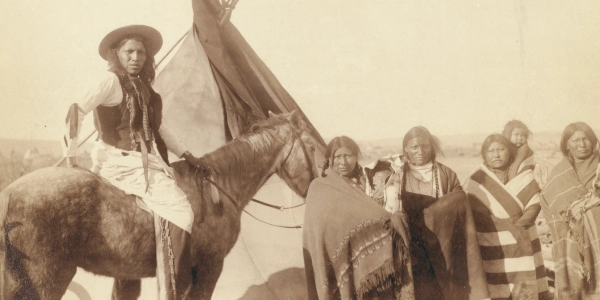
Custer State Park, South Dakota
The one thing you feel when entering the park is a sense of peace and space. Now you also get that at other locations in the Black Hills, or even other places in South Dakota, but in Custer State Park, it feels different. Tatanka reigns supreme, that's bison to the Lakota, as well as the other critters. The back hiking trails are numerous, the viewpoints spectacular from the mountains, prairies, and then there's the Needle's Highway with straight up spires at every turn. And not only is there the copious amount of wildlife and nature to visit. The interpretation here is top notch.
There are six Visitor Centers. Foremost is the main Custer State Park Visitor Center, open all year, including the twenty minute film, "Spirit of Tatanka," narrated by Kevin Costner, exhibits, orientation, and summer ranger talks. The Wildlife Station Visitor Center is a small exhibit station with park ranger on site that used to be housing for staff; the Bison Center is a large complex of corrals and a large wooden building that tells the story of the bison herd; the Peter Norbeck Education Center is located near the Game Lodge as well as the main Visitor Center. It holds education programs from Memorial Day to September 30. As you make your way up to the northwest side of the park, depending on your path, there's the unique Badger Hole Historic Site, which was the cabin of the first poet laureate of South Dakota, and the Gordon Stockade, a re-creation of the historic structure that held the story of the illegal occupation of 1874-1875.
Image above: Lakota family in the Black Hills, 1891, John C.H. Grabill. Courtesy Library of Congress. Below: Grand view of some of the hills and dales of Custer State Park from one of its mountains, 2024. Courtesy America's Best History.
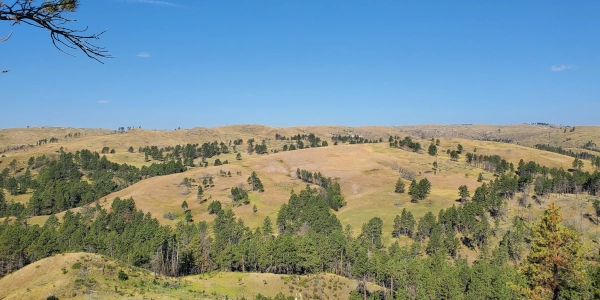
Where Is It
The Custer State Park Visitor Center is a good place to start, but there are many entrances to the 71,000 acre park. It is located at the intersection of US Highway 16A and Wildlife Loop Road. The park is located south of Keystone and north of Wind Cave National Park and Hot Springs, South Dakota.
Minute Walk in History
A drive through the loop road of Custer State Park is a spectacular nature ride through a herd of one thousand plus bison, prong horn antelope, wild burros, Visitor Centers, cool old lodges, lakes, and Needles Highway. Although less known than its Black Hills brother Mount Rushmore, it is a must see when traveling through South Dakota. Get a glimpse here of the sites you have already or will see.
What is There Now
Custer State Park, South Dakota
Okay, there is so much to see, this might be more like a list than a description. Let's say you start at the Visitor Center, with film, exhibits, facilities, and orientation, then you head down the western side of the Loop Road. First up, Wildlife Station Visitor Center. Of course, wildlife is all over, but when we were there, most of the big beasts started after that. There is the Bison Center, where they corral the buffalo after the September roundup. Lots of fun exhibits inside. Bison, Big Horn Sheep, Prong Horn Antelope, etc. And don't forget the prairie dogs and wild, but friendly, burros. They are the only, still beware, friendly animals here. There are horse camps and campgrounds. Also a few general stores, the Peter Norbeck Education Center, the Black Hills Playhouse, and the awesome Needles Highway, with two tunnels if you head toward Sylvan Lake.
When Open and How Much
There is a $20 vehicle fee to enter the park, which is good for seven days. Annual passes are also available. It is open year round. Some building may be closed on some days and winter will bring lots of snow.
Fees and hours are subject to change.
Website
Custer State Park
History Nearby
The entire area of the Black Hills has so many attractions, you could spend weeks exploring them all. They cover mining history, monuments at Mount Rushmore and the Crazy Horse Memorial, two National Park Service caves and others, plus wild west towns (less wild today than in the past) like Sturgis, Custer, Hill City, Keystone, Rapid City, and more.
-
Mount Rushmore
-
Wind Cave
National Park -
Crazy Horse Memorial
-
Black Hills
-
Jewel Cave
National Monument -
Minuteman Missile
National Monument -
Badlands
National Park
Photos, History, and More Spotlights
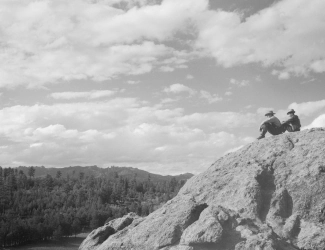
History of the Land
Of course this land was originally home to the Lakota Indians, whose origin story begins in the cave at Wind Cave National Park. It was home to herds of buffalo that rose into the hundreds of thousands until white European hunters destroyed the nomadic life of the Lakota (known as Sioux to the settlers).
The history of the park began in 1897, but was consolidated from scattered blocks of school lands into what is nearly the current park boundaries in 1912 when it was designated Custer State Forest. Governor Peter Norbeck had that designation changed to Custer State Park on July 1, 1919. The herds had already been started by then; thirty-six bison in 1914; 12 pronghorn antelope in 1916. In 1922, eight Rocky Mountain Big Horn Sheep were added the same year Needles Highway was completed. By 1924, the bison herd had grown to one hundred.
During the depression days of the 1930's, the Civilian Conservation Corps built many of the roads and campgrounds; they also built three dams that created the recreation lakes. In 1946, the Custer State Park Playhouse was opened. They were at first held in a tent near Legion Lake. By 1961, visitation reached one million people per year. The new Visitor Center was opened in 2016.
Photo above: Two men on a mountain within what's now Custer State Park, 1936, Arthur Rothstein, U.S. Farm Security Administration/Office of War Information. Courtesy Library of Congress.
Buy Second Edition
America's Best History Timeline

Great book to keep middle school to college students up to date on their American history.
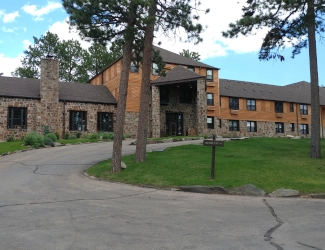
Custer State Park Lodges
The State Game Lodge - Located near the main Visitor Center, but not along the Loop Road. You must take Route 16a across the top center of the park. It was built in 1920 and was the Summer White House of President Calvin Coolidge. Situated in a valley enclosed by Ponderosa Pines and other stately trees, this is the largest resort in the park. The lodge includes cabins and hotel rooms, both inside the historic main lodge, or in other lodges attached. One, the Creekside Lodge, is separate. The dining room is splendid.
Legion Lake Lodge - Again located on Route 16a and Route 87 as it runs north, the lodge sits on Legion Lake, both named for the American Legion Post that used to rent the land. There is a Legion Lake store with gift shop and a Dockside Grill after your foray that just might include fishing, boating, and swimming.
Blue Bell Lodge - Located along the Loop Road on Highway 87 as it approaches the west central part of the park. This is a small log cabin that has chuckwagon cookouts, live entertainment, and trail rides. Only thirty cabins here plus a general store and restaurant.
Sylvan Lake Lodge - The lodge and lake are located near the northwest entrance to the park, along the western edge of Highway 87, Needles Highway. After traveling into the park or up Needles Highway, you come to a beautiful lake with a country store on its shoulder. The lodge itself is on the hillside above the lake in a forest of pine. It is made of stone and timber. An auditorium sits near the lake.
Image above: Sylvan Lake Lodge in the northwest section of the park, 2024. Courtesy America's Best History. Below: Interior of the Custer State Park Visitor Center, 2024. Courtesy America's Best History.
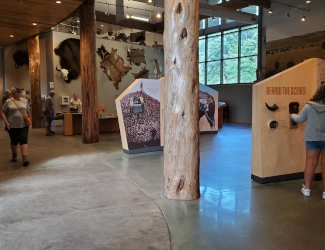
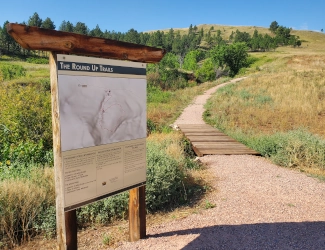
The Custer State Park Roundup
The park attempts to keep its herd around one thousand to one thousand four hundred, depending on the amount of rainfall and forage. The bison are not fed by man, just the nature that abounds in the park. During the last week of September, a decision is made on how many of the herd need to be culled. They are sold to other parks or for meat. The Buffalo Roundup is held on a single day. The Buffalo Roundup Arts Festival is held on three days around the same time near the State Game Lodge. The Roundups began in 1965.
The Roundup itself is a spectacular sight to witness, bringing the feels of the wild western cowboys and cowgirls rounding up a herd in centuries past. There are two viewing areas roped off for visitors and today's cowboys and cowgirls round up the entire herd into the corrals off Wildlife Loop Road near the Bison Center. After the herd is driven into the corrals, there is testing, branding, and sorting to watch. This day is free to visit and there are concessions for food and drink. The buffalo auction is held in November.
Photo above: Wayside to the Roundup Trail where the September event ends up at the Buffalo Center, 2024. Courtesy America's Best History.

T-Shirts and Gifts from the official souvenirs of Americasbesthistory.com.
About
America's Best History where we take a look at the timeline of American History and the historic sites and national parks that hold that history within their lands.
Photos courtesy of the Library of Congress, National Archives, National Park Service, americasbesthistory.com and its licensors.
- Contact Us
- About
- © 2025 Americasbesthistory.com.
Template by w3layouts.


